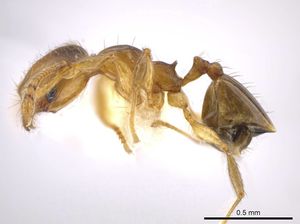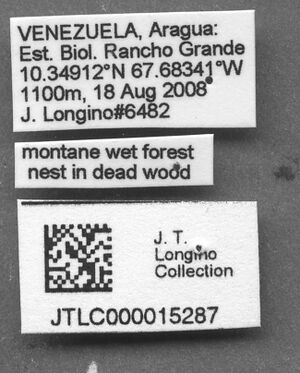Pheidole eparmata
| Pheidole eparmata | |
|---|---|

| |
| Scientific classification | |
| Kingdom: | Animalia |
| Phylum: | Arthropoda |
| Class: | Insecta |
| Order: | Hymenoptera |
| Family: | Formicidae |
| Subfamily: | Myrmicinae |
| Tribe: | Attini |
| Genus: | Pheidole |
| Species: | P. eparmata |
| Binomial name | |
| Pheidole eparmata Wilson, 2003 | |
Nothing is known about the biology of eparmata.
Identification
See the description in the nomenclature section.
Keys including this Species
Distribution
Only known from the type locality.
Latitudinal Distribution Pattern
Latitudinal Range: 10.34833333° to 10.06687°.
| North Temperate |
North Subtropical |
Tropical | South Subtropical |
South Temperate |
- Source: AntMaps
Distribution based on Regional Taxon Lists
Neotropical Region: Venezuela (type locality).
Distribution based on AntMaps
Distribution based on AntWeb specimens
Check data from AntWeb
Countries Occupied
| Number of countries occupied by this species based on AntWiki Regional Taxon Lists. In general, fewer countries occupied indicates a narrower range, while more countries indicates a more widespread species. |

|
Estimated Abundance
| Relative abundance based on number of AntMaps records per species (this species within the purple bar). Fewer records (to the left) indicates a less abundant/encountered species while more records (to the right) indicates more abundant/encountered species. |

|
Biology
Castes
Worker
Minor
Images from AntWeb
   
| |
| Worker. Specimen code jtlc000015287. Photographer M. Pierce, uploaded by University of Utah. | Owned by JTLC. |
Nomenclature
The following information is derived from Barry Bolton's Online Catalogue of the Ants of the World.
- eparmata. Pheidole eparmata Wilson, 2003: 684, figs. (s.w.) VENEZUELA.
Unless otherwise noted the text for the remainder of this section is reported from the publication that includes the original description.
Description
DIAGNOSIS Major: somewhat similar to Pheidole subarmata and related species (see under subarmata), but very small, with frontal lobes less extended in side view; shallow antennal scrobes present; head bicolored (see under Color below); eyes set well forward, so that their distance from the anterior genal border is only slightly more than an Eye Length; postpetiole seen from above oval; all of frontal lobes covered by carinulae, which extend more than halfway from level of eyes to level of occiput.
Minor: eye placed well forward on head, such that distance to anterior genal border is less than an Eye Length.
MEASUREMENTS (mm) Holotype major: HW 0.62, HL 0.76, SL 0.36, EL 0.08, PW 0.34. Paratype minor: HW 0.40, HL 0.44, SL 0.34, EL 0.06, PW 0.24.
COLOR Major and minor: brownish yellow.
Figure. Upper: holotype, major. Lower: paratype, minor. Scale bars = 1 mm.
Type Material
VENEZUELA: Rancho Grande, Estado Aragua, 1100 m, col. William L. and Doris E. Brown. Museum of Comparative Zoology
Etymology
L eparmata, armed upon or in addition to, in reference to the similarity to subarmata and related species.
References
- Wilson, E. O. 2003. Pheidole in the New World: A dominant, hyperdiverse ant genus. Harvard University Press, Cambridge, MA. (page 684, fig. major, minor described)
- Casadei-Ferreira, A., Fischer, G., Economo, E.P. 2020. Evidence for a thoracic crop in the workers of some Neotropical Pheidole species (Formicidae: Myrmicinae). Arthropod Structure, Development 59, 100977 (doi:10.1016/J.ASD.2020.100977).
References based on Global Ant Biodiversity Informatics
- Fernández, F. and S. Sendoya. 2004. Lista de las hormigas neotropicales. Biota Colombiana Volume 5, Number 1.


